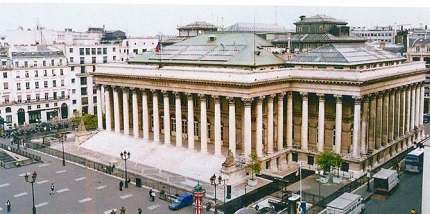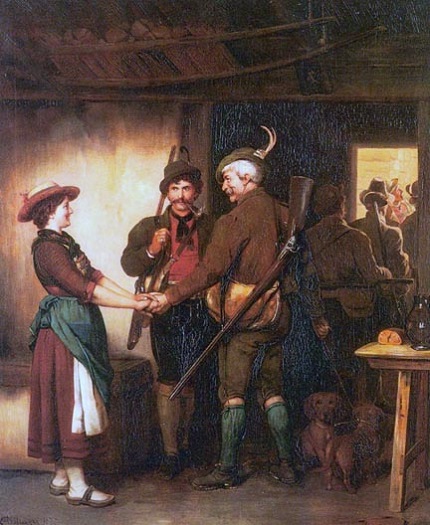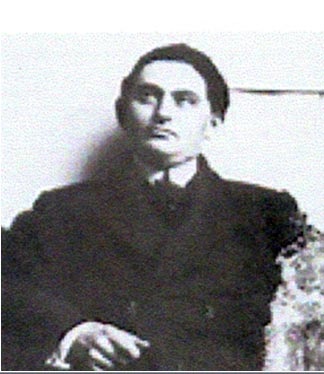
| Print | Back |  |
July 27, 2015 |
 |
Moments in Art Lost in the Stock Exchangeby Lawrence Jeppson |
Twelve Noon. The taskmastering old clock in the Paris Stock Exchange impersonally struck the hour, and Broker Tardieu turned to the other agents clustering hurriedly into the central cage to begin the day's hectic barterings.
For the next three hours Tardieu’s indivisible attention would be occupied by the buying and selling of shares in French industry and commerce.
As on every day just as the clock gonged, one of his young trainees, a German relative of a friend, made it a point of catching Tardieu's eye. Then for three hours the mercurial youth would disappear, only to pop up at Tardieu's side precisely as the clock tolled three and the end of the trading session.
During these three hours of absence Tardieu's apprentice helper was down near the Seine in the Louvre, day after day studying and digesting centuries of the world's most esteemed art, an esoteric pursuit far more engrossing than grumpy manipulations at the Bourse.
Napoleon still ruled France and most of continental Europe when the Bourse began construction. It was a huge, Creek colonnaded, Roman, rectangular pile run by about 60 agents registered and regulated by the government. Only French citizens could be agents, and they could not trade for their own accounts.

A short time after the young German began this pattern he ventured into a Left Bank state museum that no longer exists as such. He said of this, "The Luxembourg seemed to me a thing of absolutely no interest except one small room which intrigued me a great deal. This room contained a collection left to the State called the 'Collection Caillebotte.' The painters found there were called 'Impressionists.'"
(See my column “The Impressionist Who Saved the Impressionists,” 4 Nov. 2013.)
At the time, 1902, the Caillebotte painters were still not appreciated by the bulk of Frenchmen, and they disturbed the eighteen-year-old boy from across the Rhine. He had been accustomed in his father's house only to picture postcard painters like Franz Von Defregger, whose Tyrolean mountains later became much admired by Adolph Hitler.

To a young German, the Caillebotte pictures made no sense.
He was as perplexed as the French.
The Caillebotte collection "proved that, for everyone, the understanding and even the mere reading of a new painting is difficult ... at the beginning these pictures seemed to me undecipherable."
During the next seven decades, this wanderer from the Bourse, become art dealer, would champion a far more radical art than Caillebotte could ever have imagined, art that, even three generations later, millions in the street still find arcane and incomprehensible.

The young German Jew was destined to become the most important art dealer of the 20th Century. And one of the most obliging men I ever interviewed.
Daniel-Henry Kahnweiler was born on 25 June 1884, in Mannheim, Germany, but when he was five his Palatinate family moved southward to Stuttgart, where he went to school and established his strongest place attachments of youth.
On his mother's side there was great wealth: his father served as agent for one of her brothers, who was an expatriate, outside stockbroker in London and was deeply involved in trading shares in gold mines.
Another brother who had gone to London, Sigmund Neumann, was the big businessman in the family, being one of the founders of gold and diamond mining companies in South Africa. The father of these enterprising brothers had been a dealer in precious metals.
On the boy's paternal side the family had been successful importers of colonial products, notably coffee.
Daniel-Henry felt a warm love for his father's family, but he found himself more and more swept into the eddies of the maternal. His favorite relative was Uncle Joseph Goldscheider, actually his mother's uncle, who insisted that the boy call him Uncle Amico, which was Italian for friend.
A man of delving curiosity, Uncle Amico wrote elegantly about his passions: liberty, literature, music, theatre, actresses. Together, boy and uncle took long, philosophical walks in the forest encircling Stuttgart, and from these Daniel-Henry forever retained a delight in mountain hiking and insatiable zest for intellectual discovery.
Except for a few 400-year-old German paintings in the museum, there was little art in Stuttgart to beckon him, and at 16 the boy dreamed of becoming an orchestra conductor.
A musical career was nothing the Kahnweilers had ever dreamed of for their son. When he finished his school examinations in 1900, they pocketed him away behind the lattice-iron cages of various German banks. This lasted a scant two years, when one of the uncles arranged the place in Paris with Tardieu. Having been blessed with Gallic governesses since birth, he spoke fluent French.
The young man’s situation in Paris was common enough for sons of rich families: he was with Tardieu to learn as much as he could, and since this was a favor to the family, Tardieu did not pay the young man, who each month received an allowance from home that was ample enough that he could attend the theatre and occasionally buy a reproduction of some painting he had come to admire during his dallyings in the Louvre.
Jean Jaurès was founding the French Socialist party when Daniel-Henry arrived. The air hung with French agitation for the return of Alsace and Lorraine and the Five Million, which had been taken away by German victors in the Franco-Prussian War.
The young German met no hostility because of his nationality or of the anti-Semitic aftermath of the Dreyfus Affair. He did not participate in public manifestations other than one demonstration at the tomb of Emile Zola when the celebrated writer died of asphyxiation in 1902.
At Tardieu's he met and became a lifelong friend of Eugène Reignier, the clerk in charge of stock certificates. Eugène was a remarkable fellow much like Kahnweiler in his intellectual depth and delving and in his love for music and the stage.
Alas, Eugène could never brave making the break with finance, as Daniel-Henry soon would do, even when he had a chance to cast his star with Paris's most brilliant actor, theatrical writer, and producer of the times, Aurélian Lugné-Poë, founder of l'Oeuvre Theatre.
Eugène overwhelmed Daniel-Henry with his musical knowledge and insights — and taste for long weekends.
They drank up Sarah Bernhardt and other great klieglight personalities, became virtual fixtures at some theaters (Kahnweiler saw Pelléas et Mélissande 16 times), commiserated over the low quality of the Paris Opera, and on Saturdays ran to catch the earliest train they could to Marseille, or Chartres, or Reims, or La Loire, to return only on Monday mornings barely in time to get to work.
Kahnweiler's boyhood exchanges with Uncle Amico and his adventuring with Reignier stirred intellectual eddies that, in art, could not be calmed by reflections in either Luxembourg or Louvre. After the shock of his first visual combat with the Caillebotte Collection he began to look elsewhere for new visions.
"Little by little I saw surge forward a new universe for me, new for all of us, a universe where clouds circled, where the light was what I thought was seen outdoors, where shadows were blue and not black as in prior painting, in effect this universe created for us by the Impressionists — for it is the painters who create the visual universe for humanity." (My italics)
There were no art publications to guide Daniel-Henry and scarcely any qualified critics on contemporary art in the daily papers. So he began to make the rounds of art manifestations. He did not go into pilot galleries such as Durand-Ruel’s or Vollard’s, the bastians of Impressionism. They were too formidable and frightening.
Instead, he began frequenting the famous public salons, where he could be an anonymous one among many: the Salon des Artistes Français, Salon de la Société Nationale des Beaux Arts, Salon des Indépendents, and the Salon d’Automne.
Kahnweiler discovered that instead of buying reproductions of old, hallowed stuff in the Louvre, he could get more pleasure from purchases of original graphics found in some of the smaller shops. He soon owned original pulls by Bonnard, Vuillard, Cézanne, Lautrec, Manet, Renoir, and Sisley, none of which cost him very much.
Kahnweiler’s allowance was ample enough to permit him to marry. He had fallen in love with Luci, and they were married on 5 November 1904. (Frances and I married on the same date 48 years later.) He was 20.
His long weekends became longer in time and distance, for the joyful newlyweds had identical interests, and their frequent trips included Spain and Italy. Since Kahnweiler’s services cost Tardieu nothing, his patron little cared how long or often the fellow was absent. Yet it was apparent to everyone that Daniel-Henry was not setting the Bourse on fire, nor ever would.
At the end of the next year, Uncle Sigmund, who later would be knighted by King Edward VII, brought the couple to London. The young man’s lackadaisical commitment to the family would be broken.
But a hollow, dark problem lurked. Rich Uncle Sigmund was not really a man of affairs: he did not have a cluster of businesses to run, only mine-invested money to manage. Scarcely a score of people were needed for this work, and Uncle Sigmund had his own sons to groom.
Kahnweiler was expected to hone his understanding and commitment to the family fortune. Competing against his cousins gave Kahnweiler no hope.
In place of the Louvre, Luxembourg, and salons, Kahnweiler and his wife substituted the National Gallery, British Museum, and Wallace Collection. He felt no necessity to become excessively rich.
Then Uncle Sigmund decided to put a decisive end to the delicate situation.
“You have nothing more to learn in London. The time has come for you to learn the South African operation. I’m sending you to my office in Johannesburg.”
Daniel-Henry had a startling answer.
“Down there,” he retorted, “I’d only do what I’ve done here and what I have done before. I’ll never get anywhere in all this. What I want to be is a picture dealer.”
Break from family clutches was not going to be easy, but the young married man had cast the dice. Little did he foresee that he was going to become such a dominant force in modern art.
| Copyright © 2025 by Lawrence Jeppson | Printed from NauvooTimes.com |